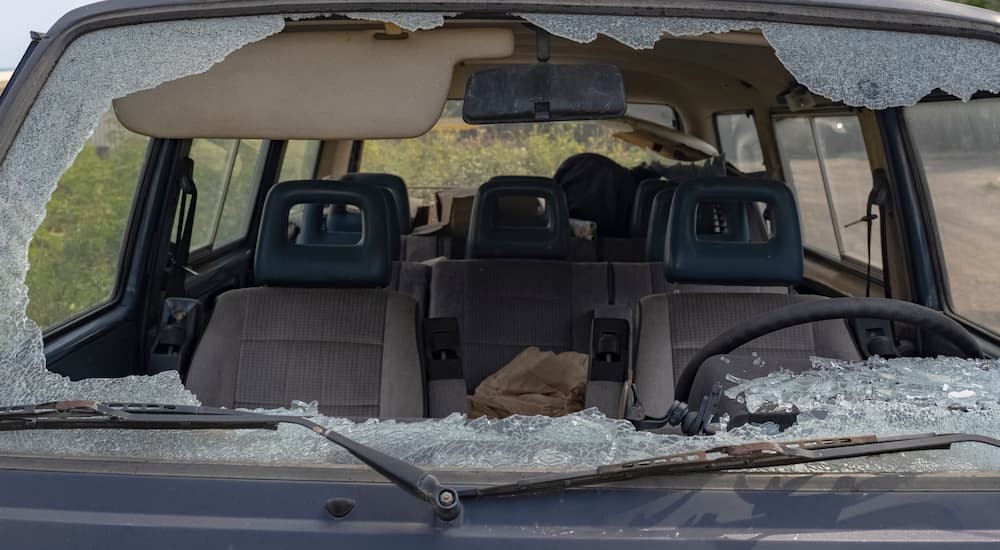Almost everyone reading this has experienced at least one chip or crack in their vehicle windshield. Have you wondered why the windshield simply cracks instead of breaking into thousands of tiny pieces when a rock strikes? You can thank laminated glass for that. Pioneered in the early 1900s just as the automotive industry was finding its footing, this safety glass has become the standard for car windshields and is used in many other walks of life.
If you’ve ever wanted to know more about laminated glass, you’ve come to the right place. This guide explains how laminated glass works, the history behind the materials, and why it’s preferred to other safety glass options.
What Is Laminated Glass?
Laminated glass consists of two thin glass sheets, also called layers or panes, bonded by at least one clear polymer plastic film. Polyvinyl butyral (PVB) is the most common polymer, though others can be used, such as thermoplastic polyurethane (TPU) and ethylene-vinyl acetate (EVA). The result is a single sheet of glass that is sturdier and less likely to break apart than regular glass. Instead, it cracks with a “spider web” pattern.
What Are the Benefits of Laminated Glass?
The construction of laminated glass offers many advantages for drivers. While laminated glass will crack under enough force, it rarely shatters into fragments and shards, making it much less likely to cause injury. Because of its shatter resistance, laminated glass also helps prevent vehicle break-ins and forced entry. The glass provides insulation against extreme temperatures and noise, making the interior of a space more comfortable. Laminated glass has been found to block up to 99% of UV rays, which reduces the risk of sunburn and upholstery fading. Unlike shatterproof polycarbonate and other thermoplastics, laminated glass won’t turn yellow from sun exposure. Automakers can customize laminated glass with solar tint, color film, extra insulation panels, and other ways to give it the properties customers want without compromising its structural integrity.
Beyond vehicles, you’ll find laminated glass in countless forms. It’s used for office building windows, skylights, railings, and much more, making it one of the more popular safety glass options. While more expensive than standalone annealed or tempered glass, many people find it worth the added safety and insulation.

The History of Laminated Glass
Like many things in life, a happy accident led to the discovery of this material. In 1903, French scientist Edouard Benedictus was working in his laboratory when a glass flask coated in cellulose nitrate fell on the floor. The flask predictably broke and cracked, but thanks to the coating, it held together.
Benedictus spent several years working on his new glass, known as Triplex glass, before getting it patented in 1909. However, he wasn’t the first to do so. Separately, English lawyer John Crewe Wood developed a version that used Canada balsam tree resin to hold the glass layers together. He patented his laminated glass in 1905.
Almost from the beginning, laminated glass was produced with the intent of improving vehicle safety. After securing his patent, Wood created the Safety Motor Screen Company to produce windshields. Meanwhile, Benedictus filed his patent in response to a car accident where a shattered windshield caused serious injuries.
However, it was slow to catch on. This was due to various issues, including splintering and the bonding film discoloring over time. The glass also took a lot of time and money to produce. The first major use of laminated glass was for gas mask eyepieces to protect World War I soldiers, and its success helped the material pick up steam.
The invention of PVB in 1927 greatly accelerated the adaptation of laminated glass. It was soon discovered that this polymer stayed clear indefinitely, didn’t have splintering issues, and sped up the production process. This new laminated glass was soon produced on multiple continents and used by most automotive manufacturers.
Why Is Laminated Glass Used in Vehicles?
Mandates that new cars be equipped with safety glass front windshields are pretty much universal. Britain was one of the first countries to enact such a mandate when it passed the Road Traffic Act of 1930. Although laminated glass isn’t always specified, nearly every vehicle windshield made uses it because it’s the best way to comply with ejection mitigation requirements such as those laid out by the National Highway Traffic Safety Administration (NHTSA).
In the U.S., per NHTSA, ejection mitigation means that if a driver impacts a windshield or window, the vehicle must stop them from going more than 100 millimeters, or about four inches, beyond the inner surface. In other words, the windshield must keep you from flying out of the vehicle if you’re not wearing your seatbelt (which you should be, but that’s another story). The impressive strength and shatter resistance of laminated glass makes it the best choice to comply with this safety regulation.
Many other vehicles have laminated glass for other glass components, such as front windows, rear windows, rear windshields, and moonroofs. AAA released a list in 2019 that showed dozens of manufacturers using laminated non-windshield glass for some or all their vehicles, including Ford, Chevy, Audi, Volkswagen, Ram, and Toyota.

Laminated Glass vs. Tempered Glass
Although laminated glass windshields are the standard, some vehicles still use tempered glass for the rest of the windows. Tempered glass has been treated with high heat and/or chemicals during manufacturing. This makes it about four times stronger than regular annealed glass and causes it to form granular cubes instead of sharp pieces if it breaks. Still, tempered glass is not as durable or shatter-resistant as laminated glass.
Why would any automaker continue to use tempered glass? There are two main reasons. One is that tempered glass is cheaper and lighter, allowing them to build a more affordable, faster, and more fuel-efficient car. Since windows other than the windshield suffer fewer impacts, shatter resistance from debris or impacts is not as big a concern in everyday driving. The other reason is that tempered glass is easier to break in an emergency so that passengers can get out or rescue workers can get in if the door is jammed. The biggest downside is its use increases the risk of theft because it’s much easier for a burglar to break a tempered glass window.
There are two ways to tell what kind of glass your car windows are. One is to roll down the window and examine the top edge. Laminated glass will look like a sandwich with two layers, while tempered glass will be solid. The other is to find the window logo. The logo should include the full word “laminated,” “tempered,” or the first four letters of these words.
Staying Safe with Laminated Glass
With vehicle safety and functionality a never-ending priority, auto glass may continue to evolve in the coming years. Head-up displays and driver assistance projected directly onto windshields have created the need for “smart glass.” In another remarkable accident, self-healing glass was discovered in 2017, which is now increasingly common for phone screen protectors and could eventually come to the automotive world.
Until then, laminated glass remains the stalwart of windshields. The same basic technology has protected drivers and passengers for over a century. We’re thankful for laminated glass every time we get behind the wheel.

